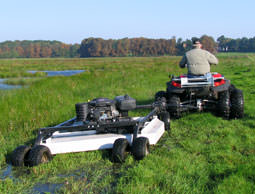
 Courtesy DR Power DR Power Walk-behind Rough-cut Mower |
The right tool for the right job is a rule to live by, especially if you have brush, heavy weeds and grasses to clear. Pulling into a field or pasture overgrown with brambles and brush with a hay mower is a recipe for damage. Pull in with a rough-cut mower built to handle the challenge, and you’ll have a job well done before you know it.
That said, not all rough-cut mowers or rotary cutters are equal. They differ in horsepower rating, width of cut, trailing versus mounted and even safety standards. Rotary cutters traditionally were tractor rear-mounted and PTO-powered. Today, they can easily trail behind a tractor, UTV or ATV. Trailing cutters may be PTO-powered or have their own gas engines. Land Pride even makes a hydraulic-motor-powered cutter that mounts on the loader arms of a skid steer.
![]() “Don’t buy more cutter than you need, but don’t undercut the power, either,” says John Quinley of Land Pride. “If you are simply cutting grass, you can go with a lighter design but with a blade speed that will give you a decent cut. If saplings and brush are to be cut, you need to look for a heavier unit, both in power and structural integrity.”
“Don’t buy more cutter than you need, but don’t undercut the power, either,” says John Quinley of Land Pride. “If you are simply cutting grass, you can go with a lighter design but with a blade speed that will give you a decent cut. If saplings and brush are to be cut, you need to look for a heavier unit, both in power and structural integrity.”
Mower Power
The beauty of today’s rough-cut mowers is the variety. There truly is one for every situation. Cutting width can vary from as little as 24-inch walk-behinds from DR Power to one of their 44-inch trailing mowers.
|
“In addition to overgrown fields, walk-behind models are especially well-suited for maneuvering in tight spots and making trails,” says Carl Eickenberg of DR Power. “Wider-cut mowers are a better choice for broad expanses.”
When it comes to wide cut, you could go with a 20-foot flex-wing cutter from Land Pride that requires a 260-horsepower tractor. More common are the 5- to 7-foot rotary cutters that require 20- to 100-horsepower tractors. Picking the size and style that is right for you requires considerable thought.
To further confuse the situation, a rotary cutter powered by a dedicated 18-horsepower motor and pulled behind an ATV or UTV may be more than equal in cutting power to a 30-horsepower tractor-powered cutter. I pull my 44-inch wide, Kunz AcrEase rough-cut mower behind my 500cc Honda Foreman. It has no problem knocking over and chewing up 2- to 3-inch saplings, 8-foot-tall giant ragweed or 2- to 3-foot cedar invading a hillside pasture. If I hit a heavy stand of brambles or weeds, I may have to slow my ground speed so the mower can chew through the material, but that’s one of the advantages of independent power.
“With the motors we put on our rough-cut mowers, an ATV operator can often mow at higher ground speeds than a cutter mounted to or pulled behind a 40-horsepower tractor,” says Matt Kunz of Kunz Engineering. “What it comes down to is how much power you are putting to the blade. A 40-horsepower tractor with a 60-inch-wide rotary cutter may only deliver 15 horsepower to the blade.”
Mower Safety and Structure
Strength of the mower gearbox and gearbox protection are key to the power issue, notes Tom Elliot of Frontier Equipment: “You want to be sure it can handle tractor horsepower, the width of the cut and the material. The slip clutch is next most important. With a rough-cut mower, you often can’t see what you are getting into, like a post or mound you are going over.”
He points out that either a slip clutch or a shear pin override will protect the gearbox. A shear pin will have to be replaced, while a slip clutch lets you keep going.
Page 1 | 2




